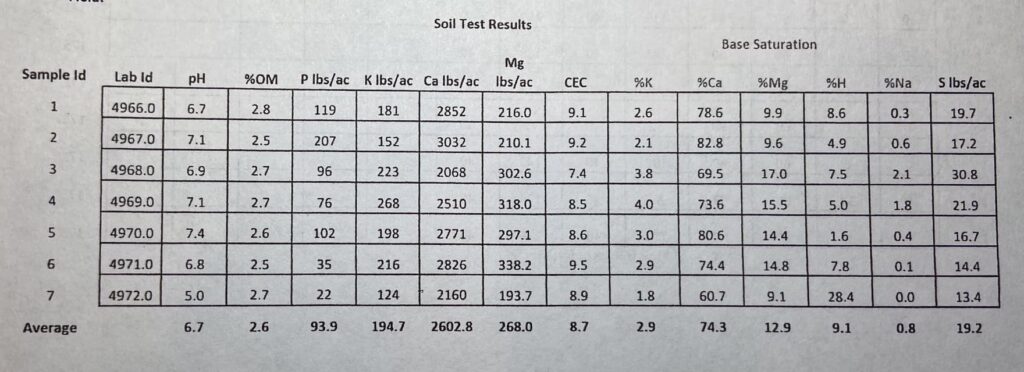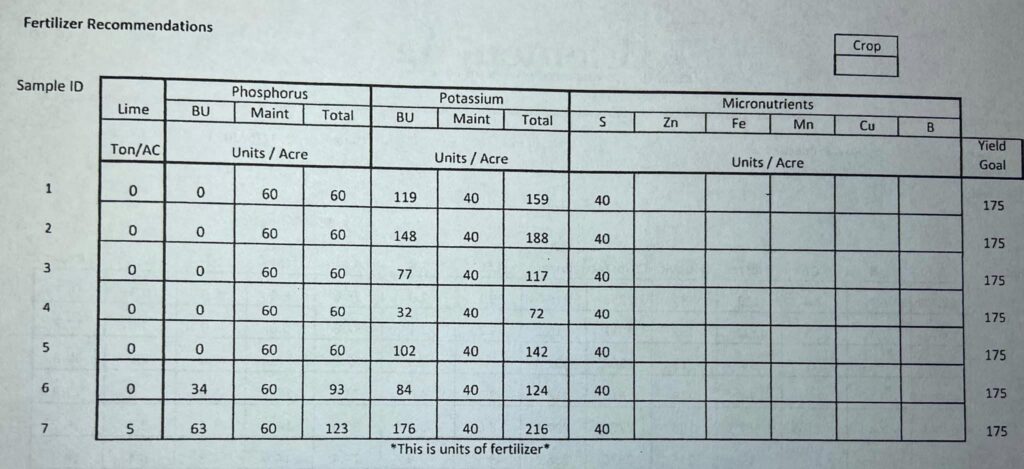As we proceed into the 2024 growing season, many concerns such as high input costs, decreasing commodity prices, futures market volatility, and crop inputs availability/supply chain issues are coming to the forefront. With that being said, we need to make sure that our calculations are correct when trying to figure crop budgets. In many instances, land rental, chemical costs, and seed have already been paid. This unfortunately leaves fertilizer on the chopping block during uncertain times. We really can’t afford to cut fertilizer, but that is what remains.
An individual, not one of my customers, contacted me for assistance with interpreting his soil test results and fertilizer recommendations he received from a soil testing laboratory. The soil test results and fertilizer recommendations below are exactly as the producer received them. There is much to be said about these numbers as they can be misleading.
When interpreting soil test data, there are a few things that one must know and/or understand about soil test values and fertilizer recommendations that are not always spelled out clearly. First, the soil test values on a report sheet from the soil test lab for Phosphorus (P), Potassium (K), Calcium (Ca), Magnesium (Mg), and all the other nutrients are expressed on an elemental basis as “parts per million (ppm) or pounds per acre (lbs/ac) of nutrient in soil”. However, the nutrients on this table are still on an elemental basis as P and K.
When we start calculating the ‘Buildup/Maintenance Requirement’ for crops using the Illinois Agronomy Handbook or Insufficient/Sufficiency Levels found in the Tri-States Recommendation Guidelines, the values in those tables (not shown) are expressed as pounds per acre of P2O5 and K2O not P and K. These values are the oxide forms of P and K fertilizers. When we look at fertilizer analysis, it is expressed as N- P2O5– K2O. When using DAP (18-46-0) and Potash (0-0-60) as examples, there is 18% N – 46% P2O5 – 0% K2O in the DAP and 0% N – 0% P2O5 – 60% K2O in the Potash.
Unfortunately, the calculations do not stop here. We need to convert P2O5 and K2O to pound per acre of product. When a producer calls their local supplier and tells them he wants 150 lbs of DAP and 200 lbs of Potash applied to a field, he is referring to pounds of product. This is achieved by taking the desired or required amount of nutrient and dividing it by the percent analysis of the fertilizer to be used. For example:
69 lbs/acre P2O5 (needed) and divide that by 0.46 (percent analysis of P2O5 in DAP) = 150 lbs/acre DAP.
120 lbs/acre K2O (needed) and divide that by 0.60 (percent analysis of K2O in Potash) = 200 lbs/acre Potash.
As stated before, the Phosphorus is expressed as “P lbs/ac” and the Potassium is expressed as “K lbs/ac” on these soil test results. Now let’s turn our attention to the Fertilizer Recommendations Table. These recommendations are coming from soil testing laboratory software and have what I call a “canned program” with general catch-all numbers to generate a fertilizer recommendation. The numbers in the program need to be tweaked to better line up with Illinois Agronomy Handbook Guidelines and Illinois NRCS Standards. This could help avoid later confusion for producers submitting paperwork to the Illinois NRCS to meet a variety of conservation practice guidelines.
Not all soil testing laboratory programs have soil testing software that generate these types of “canned program” fertilizer recommendations. The computer programs used by retail and independent agronomists for generating flat rate and variable rate fertilizer recommendations are much more complex and have most of the bases covered.
The Soil Buildup (BU) is correct for Phosphorus but is high for Potassium for this geographic region. These samples came from the “Low P-Supplying Power” and “Low CEC Regions” of Illinois. These samples should be “Built” to a 50 lbs/ac P test and a 260 lbs/ac K test. On this report, it is building to 50 for the P and 300 for the K.
With regards to the “Buildup” and “Crop Maintenance” values, nowhere on the report does it give the units being expressed. Under Phosphorus and Potassium, it shows Units/Acre and at the bottom of the table it states, “This is units of fertilizer.” Is this “Pounds of P2O5 and K2O” or “Pounds of Product” for each? As I looked closer at the Maintenance numbers, they are off ever so slightly that we’re probably just splitting hairs here. By back calculating, they are using 0.34 lbs/bu P2O5 and 0.23 lbs/bu K2O. These Maintenance numbers of 60 and 40 for P2O5 and K2O, respectively, are using the average values reported in Dr. Emerson Nafziger’s Grain P and K Summary from an Illinois Nutrient Research and Education Council (NREC) project several years ago. However, the U of I published 0.37 lbs P2O5/bu and 0.24 lbs K2O/bu to be used for making recommendations. They threw out the lower 25% and higher 25% of the obtained values from their research to come up with the new numbers. Liked I said, we’re splitting hairs, but there needs to be some clarification here because these are two very different numbers. Many people would think this is ‘Pounds of Product’ for the Maintenance and Total, but they would be wrong. This is why the report needs clarification.
In the Crop Maintenance Column, 60 lbs/ac P2O5 is actually 130 lbs/acre of Product as DAP and 40 lbs/ac K2O is actually 67 lbs/acre of Product as Potash. If you take the average of the Total Column, you will get 74 lbs/ac P2O5 and 145 lbs/ac K2O. These numbers convert to 160 lbs/acre of Product as DAP and 242 lbs/acre of Product as Potash. There’s a big difference here.
Another point of contention on this report is that the Crop Maintenance for Phosphorus does not take into consideration the Soil Test P value. For this geographical region, “Yields are Not Dependent on P Fertilizer” with a soil test P value greater than 70 lbs P/acre. Five of the seven values are more than 70 showing a large portion of this field doesn’t necessarily need phosphorus fertilization and is potentially a place to save some money.
Not every soil testing laboratory has reports needing this level of clarification and many times the laboratory can clear this up for you rather quickly. If producers run into a situation like this, there are a wealth of resources at your disposal that can help you through these calculations. People with Illinois Soybean Association, local retailers/agronomists, and independent agronomists will be happy to help you.






 and then
and then